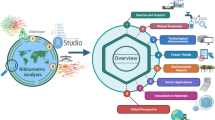Abstract
The nitroaromatic explosive 2,4,6-trinitrotoluene (TNT) is a reactive molecule that biotransforms readily under both aerobic and anaerobic conditions to give aminodinitrotoluenes. The resulting amines biotransform to give several other products, including azo, azoxy, acetyl and phenolic derivatives, leaving the aromatic ring intact. Although some Meisenheimer complexes, initiated by hydride ion attack on the ring, can be formed during TNT biodegradation, little or no mineralization is encountered during bacterial treatment. Also, although the ligninolytic physiological phase and manganese peroxidase system of fungi can cause some TNT mineralization in liquid cultures, little to no mineralization is observed in soil. Therefore, despite more than two decades of intensive research to biodegrade TNT, no biomineralization-based technologies have been successful to date. The non-aromatic cyclic nitramine explosives hexahydro-1,3,5-trinitro-1,3,5-triazine (RDX) and octahydro-1,3,5,7-tetranitro-1,3,5,7-tetrazocine (HMX) lack the electronic stability enjoyed by TNT or its transformed products. Predictably, a successful enzymatic change on one of the N–NO2 or C–H bonds of the cyclic nitramine would lead to a ring cleavage because the inner C–N bonds in RDX become very weak (<2 kcal/mol). Recently this hypothesis was tested and proved feasible, when RDX produced high amounts of carbon dioxide and nitrous oxide following its treatment with either municipal anaerobic sludge or the fungus Phanaerocheate chrysosporium. Research aimed at the discovery of new microorganisms and enzymes capable of mineralizing energetic chemicals and/or enhancing irreversible binding (immobilization) of their products to soil is presently receiving considerable attention from the scientific community.
Similar content being viewed by others
Author information
Authors and Affiliations
Additional information
Received: 14 February 2000 / Received revision: 9 June 2000 / Accepted: 13 June 2000
Rights and permissions
About this article
Cite this article
Hawari, J., Beaudet, S., Halasz, A. et al. Microbial degradation of explosives: biotransformation versus mineralization. Appl Microbiol Biotechnol 54, 605–618 (2000). https://doi.org/10.1007/s002530000445
Issue Date:
DOI: https://doi.org/10.1007/s002530000445




